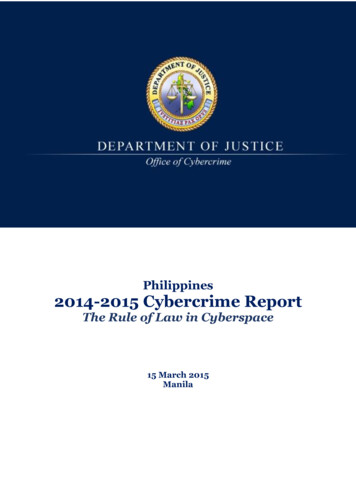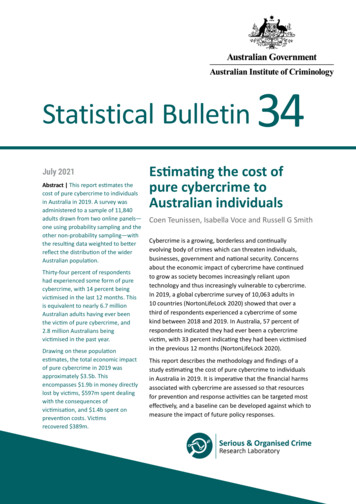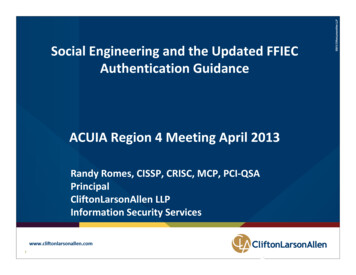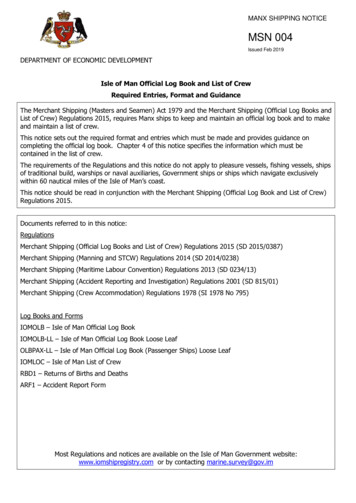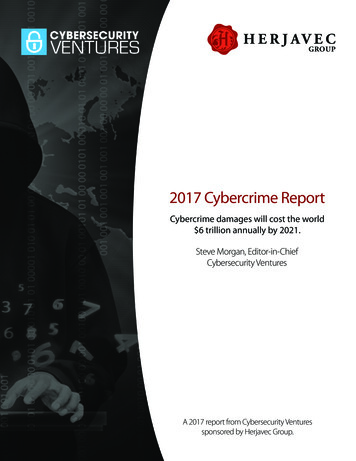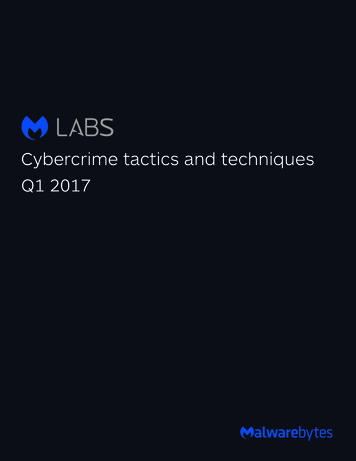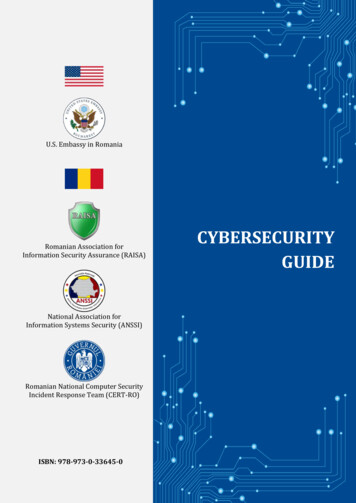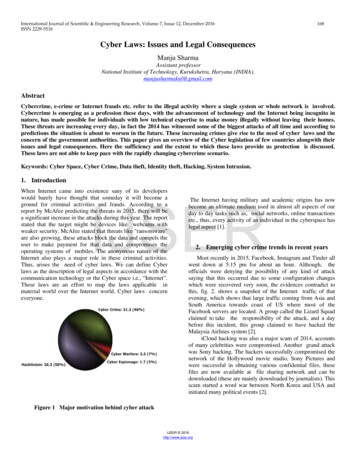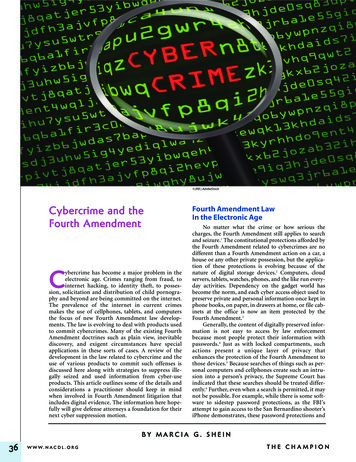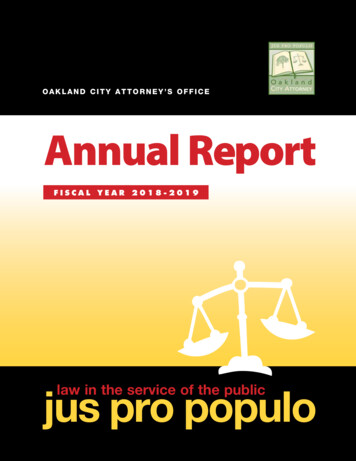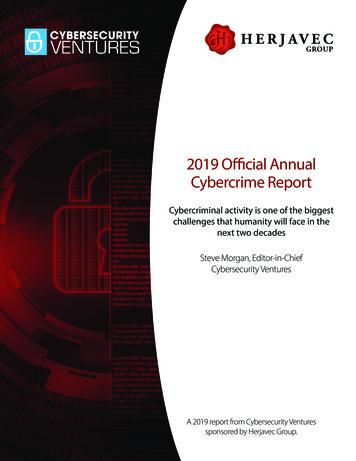
Transcription
2019 Official AnnualCybercrime ReportCybercriminal activity is one of the biggestchallenges that humanity will face in thenext two decadesSteve Morgan, Editor-in-ChiefCybersecurity VenturesA 2019 report from Cybersecurity Venturessponsored by Herjavec Group.
IntroductionCybersecurity Ventures predicts cybercrime will cost the world in excess of 6 trillion annually by 2021, up from 3 trillion in 2015.Cybercrime is the greatest threat to every companyin the world, and one of the biggest problems withmankind. The impact on society is reflected in thenumbers.the FBI agent fast on his heels. “Up until now it’s just afinancial crime for the purpose of stealing money – orstealing data that is money – but we have the abilitynow to turn someone’s pacemaker off.”In August of 2016, Cybersecurity Ventures predictedthat cybercrime will cost the world 6 trillion annuallyby 2021, up from 3 trillion in 2015. This represents thegreatest transfer of economic wealth in history, risksthe incentives for innovation and investment, and willbe more profitable than the global trade of all majorillegal drugs combined.Cybersecurity Ventures’ damage cost projections arebased on historical cybercrime figures including recentyear-over-year growth, a dramatic increase in hostilenation state sponsored and organized crime ganghacking activities, and a cyber attack surface whichwill be an order of magnitude greater in 2021 than itis today.The cybercrime prediction stands, and over the pasttwo-plus years it has been corroborated by hundredsof major media outlets, academia, senior governmentofficials, associations, industry experts, the largesttechnology and cybersecurity companies, andcybercrime fighters globally.Cybercrime costs include damage and destructionof data, stolen money, lost productivity, theft ofintellectual property, theft of personal and financialdata, embezzlement, fraud, post-attack disruption tothe normal course of business, forensic investigation,restoration and deletion of hacked data and systems,and reputational harm.Frank W. Abagnale, an FBI consultant for over 40 yearsand one of the world’s most respected authoritieson forgery, embezzlement, and secure documents,concurs with the 6 trillion cybercrime damage costprediction. “I’m very concerned with cyber starting toturn very dark,” says Abagnale, the inspiration for StevenSpielberg’s 2002 film, Catch Me If You Can, starringLeonardo DiCaprio as Abagnale and Tom Hanks as“This dramatic rise (in damage costs) only reinforcesthe sharp increase in the number of organizationsunprepared for a cyber attack,” says Robert Herjavec,founder and CEO at Herjavec Group, a ManagedSecurity Services Provider with offices and SOCs(Security Operations Centers) globally.
IntroductionCyber attacks are the fastest growing crime in the U.S., and they are increasing in size, sophistication and cost.A major data breach — the second largest ever — suffered by Marriott and disclosed near the end of 2018, isestimated to have exposed 500 million user accounts. The Yahoo hack — the largest ever — was recalculated tohave affected 3 billion user accounts (up from an earlier estimate of 1 billion), and the Equifax breach in 2017 —with 145.5 million customers affected — exceeded the largest publicly disclosed hacks ever reported up until thattime. These major hacks alongside the WannaCry and NotPetya cyber attacks, which occurred in 2017 are not onlylarger scale and more complex than previous attacks, but they are a sign of the times.The cybercrime epidemic has hit the U.S. so hard that a supervisory special agent with the Federal Bureau ofInvestigation who investigates cyber intrusions told The Wall Street Journal that every American citizen shouldexpect that all of their data (personally identifiable information) has been stolen and is now on the dark web.“DDoS attacks, ransomware, and an increase in zero day exploits are contributing to the cybercrime damagesprediction becoming a reality,” adds Herjavec. “What really worries me though, is that all the hype around cybercrime– the headlines, the breach notices etc. – makes us complacent. The risk is very real and we can’t allow ourselves tobe lulled into a sense of inevitability.”“This dramatic rise (in damage costs) only reinforces the sharp increase in the number oforganizations unprepared for a cyber attack.”-- Robert Herjavec, Founder & CEO at Herjavec Group
Cyber Attack SurfaceOur entire society, the Planet Earth, is connecting upto the Internet – people, places, and Things. The rate ofInternet connection is outpacing our ability to properlysecure it.The World Wide Web was invented in 1989. The firstever website went live in 1991. Today there are nearly1.9 billion websites.There were nearly 4 billion Internetusers in 2018 (nearly half of the world’spopulation of 7.7 billion), up from2 billion in 2015.Cybersecurity Ventures predicts that there will be6 billion Internet users by 2022 (75 percent of theprojected world population of 8 billion) — and morethan 7.5 billion Internet users by 2030 (90 percent ofthe projected world population of 8.5 billion, 6 years ofage and older).Like street crime, which historically grew in relationto population growth, we are witnessing a similarevolution of cybercrime. It’s not just about moresophisticated weaponry; it’s as much about thegrowing number of human and digital targets.“The degree of difficulty in protecting businessesfrom cyber attacks grows in proportion to a numberof factors,” says Herjavec. “Emerging threat actors, theprominence of interconnected devices and the mostcritical in my opinion – the VAST amount of data thatneeds to be secured – are all adding to this complexchallenge.”Microsoft helps frame digital growth with its estimatethat data volumes online will be 50 times greater in2020 than they were in 2016.Cisco confirmed that cloud data center traffic willrepresent 95 percent of total data center traffic by 2021.Or to put it another way – cloud computing will wipeout data centers altogether over the next 3-4 years.Cybersecurity Ventures predicts that the totalamount of data stored in the cloud – which includespublic clouds operated by vendors and social mediacompanies (think AWS, Twitter, Facebook, etc.),government owned clouds that are accessible tocitizens and businesses, and private clouds owned bymid-to-large-sized corporations – will be 100X greaterin 2021 than it is today.‘The Big Data Bang’ is an IoT world that will explode from2 billion objects (smart devices which communicatewirelessly) in 2006 to a projected 200 billion by 2020,according to Intel.
Cyber Attack SurfaceGartner forecasts that more than half a billionwearable devices will be sold worldwide in 2021, upfrom roughly 310 million in 2017. Wearables includessmartwatches, head-mounted displays, body-worncameras, Bluetooth headsets, and fitness monitors.Despite promises from biometrics developers of afuture with no more passwords — which may in factcome to pass at one point in the far out future — a2017 report found that the world will need to cyberprotect 300 billion passwords globally by 2020.There are more than 111 billion lines of new softwarecode being produced each year — which introduces amassive number of vulnerabilities that can be exploited.The world’s digital content is expected to grow from 4billion terabytes (4 zettabytes) in 2016 to 96 zettabytesby 2020 (this is how big a zettabyte is).The far corners of the Deep Web — known as the DarkWeb — is intentionally hidden and used to conceal andpromote heinous criminal activities. Some estimatesput the size of the Deep Web (which is not indexedor accessible by search engines) at as much as 5,000times larger than the surface web, and growing at arate that defies quantification, according to one report.ABI has forecasted that more than 20 million connectedcars will ship with built-in software-based securitytechnology by 2020 — and Spanish telecom providerTelefonica states by 2020, 90 percent of cars will beonline, compared with just 2 percent in 2012.Hundreds of thousands — and possibly millions — ofpeople can be hacked now via their wirelessly connectedand digitally monitored implantable medical devices(IMDs) — which include cardioverter defibrillators(ICD), pacemakers, deep brain neurostimulators, insulinpumps, ear tubes, and more.Dr. Janusz Bryzek, Vice President, MEMS and SensingSolutions at Fairchild Semiconductor predicts that therewill be 45 trillion networked sensors in twenty yearsfrom now. This will be driven by smart systems includingIoT, mobile and wearable market growth, digital health,context computing, global environmental monitoring,and IBM Research’s “5 in 5” — artificial intelligence (AI),hyperimaging, macroscopes, medical “labs on a chip,”and silicon photonics.
Cybersecurity SpendingCybercrime is creating unprecedented damage to both private and public enterprises, and driving up ITsecurity spending.Worldwide spending on information security (a subset of the broader cybersecurity market) products and serviceswill reach more than 114 billion (USD) in 2018 *, an increase of 12.4 percent from last year, according to the latestforecast from Gartner, Inc. In 2019, the market is forecast to grow 8.7 percent to 124 billion.* The Gartner forecast doesn’t cover various cybersecurity categories including IoT (Internet of Things), ICS (IndustrialControl Systems) and IIoT (Industrial Internet of Things) security, automotive cybersecurity, and others.Cybersecurity Ventures predicts global spending on cybersecurity products and services will exceed 1 trillioncumulatively over the five year period from 2017 to 2021. Taken as a whole, we anticipate 12-15 percent year-overyear cybersecurity market growth through 2021.Global spending on cybersecurity will exceed 1 trillion cumulatively for the5 year period from 2017-2021, according to Cybersecurity Ventures.IT analyst forecasts remain unable to keep pace with the dramatic rise in cybercrime, the ransomware epidemic,the refocusing of malware from PCs and laptops to smartphones and mobile devices, the deployment of billions ofunder-protected Internet of Things (IoT) devices, the legions of hackers-for-hire, and the more sophisticated cyberattacks launching at businesses, governments, educational institutions, and consumers globally.“Problem is (for tracking cybersecurity spending), tech giants — with the exception of IBM and Cisco Systems —don’t always break out cybersecurity revenue figures and a large cut of consumer security spending on mobilemalware and virus removal and data recovery is never reported. Much like corporations, consumers are spendingtime and money as a result of cyber attacks,” according to a story in Investors Business Daily, which helps explainpart of the delta between spending forecasts from some industry analysts and the trillion dollar 5-year marketprediction by Cybersecurity Ventures.
Ransomware RisingCybersecurity Ventures predicts that a business will fall victim to a ransomwareattack every 14 seconds by 2019, and every 11 seconds by 2021.The U.S. Department of Justice (DOJ) has describedransomware as a new business model for cybercrime,and a global phenomenon.Ransomware — a malware that infects computersand restricts their access to files, often threateningpermanent data destruction unless a ransom is paid— has reached epidemic proportions and is the fastestgrowing cybercrime.At the end of 2016, a business fell victim to aransomware attack every 40 seconds. CybersecurityVentures predicts that will rise to every 14 seconds by2019 — and every 11 seconds by 2021.Last year, the FBI estimated that the total amount ofransom payments was approaching 1 billion annually.Cybersecurity industry experts and law enforcementofficials have been advising organizations not to payransoms. While the percentage of ransom victims whopay bitcoin to hackers in hopes of reclaiming their dataappears to be on the decline, the total damage costsin connection to ransomware attacks is skyrocketing.Global ransomware damage costs were predicted toexceed 5 billion in 2017, up more than 15X from 2015.Ransomware damages are now predicted to cost theworld 11.5 billion in 2019, and 20 billion in 2021.“Ransomware attacks are in the process of morphingfrom spray-and-pray phishing blasts to highly targetedand extremely damaging network-wide infectionsthat can cause days or weeks of downtime for awhole organization,” says Stu Sjouwerman, founderand CEO at KnowBe4, a company that specializes intraining employees on how to detect and respondto ransomware attacks. “It is an unfortunate fact of lifethat ransomware is here to stay and that traditionalsoftware-based endpoint protection is not able toprotect well against this type of malware.”
Labor CrisisThe sheer volume of cyber attacks and security eventstriaged daily by security operations centers continuesto grow, making it nearly impossible for humans tokeep pace, according to Microsoft’s Global IncidentResponse and Recovery Team.Security is a people problem. People are committingthe cybercrimes. And we need qualified people topursue and catch the perpetrators.Technology is essential and we are making a lot ofprogress there, but without a sufficient army of whitehats (good guys) to go up against the growing armyof black hats (bad guys), we will not be able to bringdown the cybercrime rate.“The greatest virtual threat today is not state sponsoredcyber-attacks; newfangled clandestine malware; or ahacker culture run amok,” states John Reed Stark, formerChief of the SEC’s Office of Internet Enforcement,in a guest blog post he wrote last year. “The mostdangerous looming crisis in information security isinstead a severe cybersecurity labor shortage.”The demand for cybersecurity professionals willincrease to approximately 6 million globally by 2019,according to some industry experts cited by the PaloAlto Networks Research Center.Cybercrime will more than triple the number of jobopenings to 3.5 million unfilled cybersecurity positionsby 2021, and the cybersecurity unemployment ratewill remain at zero percent.Every IT position is also a cybersecurity position now.Every IT worker, every technology worker, needs to beinvolved with protecting and defending apps, data,devices, infrastructure, and people.“Historically, there’s been a line drawn in the sandbetween an IT organization, and its security team,” saysHerjavec. “In fact, aside from a CIO, the only other IT‘Chief’ title is CISO (Chief Information Security Officer).But it’s the larger group of IT workers that can be yourfuture cybersecurity pros. The challenge across theboard is in recruiting and retaining new security hires.”The cybersecurity workforce shortage has left CIOs,CSOs, and CISOs shorthanded and scrambling fortalent while the cyber attacks are intensifying. Securityleaders must recognize how to prioritize, and how tosacrifice, when it comes to limited human capital.“Mostly, my job (and this is true of any cybersecurityprofessional) is to determine how to allocate scarceresources to the highest risk,” says Jim Routh, ChiefSecurity Officer at CVSHealth, the largest pharmacyhealthcare provider in the U.S., with 246,000 colleaguesacross all 50 states, Washington, D.C., Puerto Ricoand Brazil. “You never have enough resources to doeverything, so you have to pick and choose where youwant to make investments in terms of the allocation ofresources,” adds Routh (previously CSO at Aetna beforebeing acquired by CVSHealth).
Security Awareness TrainingWhile the annals of hacking are studded with talesof clever coders finding flaws in systems to achievemalevolent ends, the fact is most cyber attacks beginwith a simple email. More than 90 percent of successfulhacks and data breaches stem from phishing, emailscrafted to lure their recipients to click a link, open adocument or forward information to someone theyshouldn’t.“People are the weakest link in the security chain,” saysKathy Hughes, VP and CISO at Northwell Health, one ofthe nation’s leading healthcare systems and New York’slargest private employer with 68,000 people. “Youcan have all the wonderful technologies and layers ofsecurity protections in place, but ultimately it comesdown to the person — to people being really aware ofthe threats and knowing how to detect them and howto report them,” adds Hughes, who has helped createa culture of security awareness at the healthcare giant.2018 was a breakthrough year when manyorganizations globally took the (financial) plunge andeither trained their employees on security for the firsttime, or doubled-down on more robust and ongoingsecurity awareness and phishing simulation programs.Training employees how to recognize and defend against cyber attacks is themost under spent sector of the cybersecurity industry.Northwell may be the poster child for how a largeenterprise can implement and benefit from trainingemployees on cyber threats. Hughes led theorganization’s initiatives, which included hiring asecurity awareness training manager and dedicatedstaff, and orchestrating a phishing campaign thatincludes simulated attacks on users (and groups ofusers) that are more susceptible to scams — includingnew hires.Making sure there is a security aware culture is a toppriority at Xerox, which has offices in over 160 countriesaround the world.“How large is the security organizationat Xerox?” asks Dr. Jay, VP and CISO at Xerox, and formerWhite House Deputy CIO. “The security organization is30,000 people every single employee at Xerox,” shesays, answering her own question.“The bad guys are using the same 2.99 (hacking) toolsto get to Xerox as they were to get to the White House,”adds Dr. Jay. A ‘Hacker’s Tool Kit’, as seen in Fortune,offers a cybercrime price list with tools ranging from 1to 200 — many of which can be utilized by completenovices — for injecting ransomware to stealingpersonally identifiable information (PII) to hacking intoemail accounts, and other nefarious purposes.Global spending on security awareness training foremployees is predicted to reach 10 billion by 2027,up from around 1 billion in 2014. Training employeeshow to recognize and defend against cyber attacksis the most under spent sector of the cybersecurityindustry.Employee training may prove to be the best ROI oncybersecurity investments for organizations globallyover the next 5 years.
Looking Ahead“Every company will be hacked,” according to Roger Grimes, a Computer Security Columnist for Infoworld, and 30year tech industry road warrior who spent 11 years as a Principal Security Architect at Microsoft.Healthcare providers have been the bullseye for hackers over the past three years. “In 2017 and 2018 we sawmore focus on cybersecurity investment from healthcare providers,” says Herjavec. “They’ve felt the pain of theirantiquated systems and have had to step up out of necessity to do more to protect their infrastructures and patientdata. Ransomware attacks on hospitals are predicted to increase 5X by 2021.”“We saw more and more traction this year (and we’re expecting the same for 2019) in what I call ‘traditionalindustries’,” adds Herjavec. “Particularly in the manufacturing space where compromises like cryptolocker havedone some real damage, we will see organizations maturing their security programs and investing in order to keepup with ever changing exploits. Manufacturing has become the new healthcare in 2018.”To Herjavec’s point, 40 percent of the manufacturing security professionals responding to a Cisco survey saidthey do not have a formal security strategy. Due to a general lack of investment in cybersecurity, yet a growingreliance on modern technologies, the manufacturing sector is one of the most vulnerable and targeted industries,according to Process Industry Informer, a magazine for the manufacturing sector.The construction industry was another hot target for cyber attacks in 2018. As construction companies begin tostandardize on IoT devices including thermostats, water heaters, and power systems, a whole new attack surfacewill emerge for hackers.IoT (Internet of Things) devices were the biggest technology crime driver in 2018— and all indications are that it will remain the same in 2019.Consumer products companies have emerged this year as another industry that is challenged around cyber attacksand recruiting cybersecurity talent. Millennial and Generation Z workers may find young technology or investmentbanking companies more attractive as potential employers, according to a story in The Wall Street Journal.The 5 most cyber-attacked industries in 2016 — healthcare, manufacturing, financial services, government, andtransportation — have remained largely the same, although the rank order has been changing. Every industryhas gone “Tech” — AdTech (advertising), FinTech (financial services), EdTech (educational technology), GovTech(government), LegalTech (law firms), etc. — and they all need to scale their cyber protection.
Looking AheadThe small business sector saw a bump in cybersecurity this year. A legion of small businesses woke up to the realitythat they are under cyber attack — and need to take preventative security measures. Many companies with 250 orfewer employees have learned the hard way that if they wait until after being hacked to deal with it — it may betoo late. Nearly half of all cyber attacks are committed against small businesses, and the percentage is expected tocontinue rising.One cybersecurity expert has a warning that CEOs at organizations of all types and sizes should heed: “It’s justlike preparing for hurricanes, earthquakes, any type of natural or man-made disaster that could create businesscontinuity issues — same thing with the digital cyber event,” says Theresa Payton, CEO at Fortalice Solutions, andformer White House CIO.Industries aside, IoT (Internet of Things) devices were the biggest technology crime driver in 2018 — and all indicationsare that it will remain the same in 2019 and for the foreseeable future. Cisco estimates that the number of IoT devices willbe three times as high as the global population by 2021. “The IoT devices were really built with just pure functionality inmind,” says Northwell’s CISO, Hughes. “They have very small operating systems and security is more of a ‘bolt-on’ than a‘built-in’ to those devices.”Finally, consumers are expected to pay more attention to security in 2019 in the aftermath of the Yahoo, Marriott, andother data breaches.The thought of stolen email addresses and PII (personally identifiable information), and hackers being able to read privatetext messages and listen to baby monitors may be the things that get people motivated to fight back by switching tomore secure email providers, turning on 2-step verification, and buying their first cybersecurity products.
Safety in NumbersDespite the cybercrime epidemic, technology promises to make the world a much safer place.Traffic authorities see nearly 300,000 lives saved over the next 10 years from a vast reduction in traffic fatalities usingautonomous vehicle technology.Intel announced the largest security related acquisition last year, a whopping 15.3 billion acquisition of Mobileye,an Israeli automotive technology company focused on collision avoidance — with approximately 450 engineersand an installed base of nearly 15 million vehicles.Overall crime statistics could drop by more than 20 percent when metropolitan sensors and cutting edge homesecurity remote monitoring begin to work seamlessly together through the IoT.Cyber engineers and entrepreneurs globally are hard at work on new solutions to combat and reduce cybercrime.Hundreds of top cybersecurity companies are innovating cutting edge products and creating new services in thewar against cybercrime. A growing list of MSSPs (managed security service providers) are assuming responsibilitiesfor the most daunting cyber risks faced by organizations of all sizes and types globally.Cybercrime is a natural outgrowth of the expanding cyber attack surface, and it should be expected. A realistic viewof the risks and threats we face will help organizations and consumers to do a better job of protect themselves.About Cybersecurity VenturesCybersecurity Ventures is the world’s leading researcher and publisher covering the global cyber economy. Our firm deliverscybersecurity market data, insights, and ground-breaking predictions to a global audience of CIOs and IT executives, CSOs and CISOs,information security practitioners, cybersecurity company founders and CEOs, venture capitalists, corporate investors, business andfinance executives, HR professionals, and government cyber defense leaders.For more information, visit www.cybersecurityventures.com.About Herjavec GroupAt Herjavec Group, cybersecurity is what we do. Dynamic IT entrepreneur Robert Herjavec founded Herjavec Group in 2003 to providecybersecurity products and services to enterprise organizations. We have been recognized as one of the world’s most innovativecybersecurity operations leaders, and excel in complex, multi-technology environments. We have expertise in comprehensive securityservices including Managed Security Services (SOC Operations, Threat Detection & Security Technology Engineering) and ProfessionalServices (Advisory Services, Identity Services, Technology Implementation, Threat Management & Incident Response). Herjavec Group hasoffices and Security Operations Centers across the United States, United Kingdom and Canada.For more information, visit www.herjavecgroup.com.Follow UsHerjavec Group@HerjavecGroup
"DDoS attacks, ransomware, and an increase in zero day exploits are contributing to the cybercrime damages prediction becoming a reality", adds Herjavec. "What really worries me though, is that all the hype around cybercrime - the headlines, the breach notices etc. - makes us complacent. The risk is very real and we can't allow ourselves to be lulled into a sense of inevitability .
